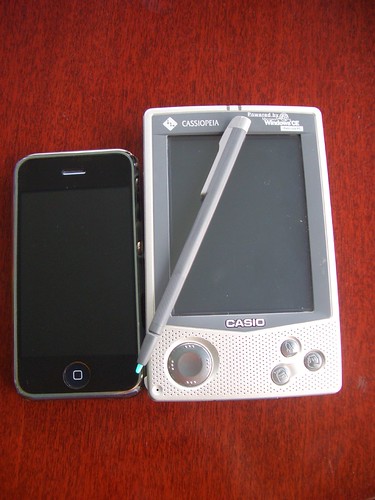There is an article in The Dom Post today which gives a reasonable commentary but misses some key points I think. I have been a user of a PDA for about 8 years, starting off with a Cassiopeia E-105 before moving on to a Dell Axim X51v, which was a quantum leap, and now the iPhone, which, again, is a massive leap forward.
Ignoring dimensions, battery life, memory and processing power, some would say not much has changed but you'd be so wrong. What has changed is quite simply the world and how we expect to interact with it; lets leap back in time to 2000.
I used my E105 at work and it was useful as a diary, some fun games and my contacts list. At the time I thought it was compact but I've just dug it out of a draw and it is a monster:

Lots of buttons and I could play music and, at the time, it was a good introduction to mobile computing. Of course, the big difference between then and now is the widespread use of WiFi and ubiquitous cellphone connectivity, but the major change is the simple fact that everything and anything can live in the cloud.
When I first started work in in 1990, I worked for one of London's major investment banks and sat in the equity dealing room with a green screen terminal that was hooked up to a whopping great mainframe computer somewhere; I vaguely recollect it was called Sperry or something and these things were indestructible. During my time, we moved away from the dumb terminal to a IBM PC set-up with a Rumba terminal emulator to connect to our host and a more classical mouse driven interface away from the hundreds of short-codes that we had to know to navigate around screens.
With this change came the requirement to run lots of applications at the same time and so faster PCs were needed and more and more memory. We've now come full circle. Here I am with a powerful Windows PC with oodles of memory and storage yet I upload my life to the cloud with Flickr and use Google Docs and it is the speed of my connection to this world that is important.
The reason this works for me is simple; I don't live my life at home yet I still want to be connected to my home life. There is no need to actually connect to my home PC as I just go to where the information is and voilà. It is this ability to connect to my personal data, from anywhere, that has revolutionised the mobile device. Whether it is my calendar, my contacts, my documents or my photos, I want, and demand, access to it from anywhere but I don't need to actually carry it with me.
Think of money. You used to have to carry it with you and then came plastic. You could leave you cash in the bank, earning interest, and still access it from a shop. Data is the same. Why carry it with you when you just need to be able to get to it when you want it. Like money, data in the cloud earns interest but the interest is the way in which disparate pieces of information clump together to be more useful; think of adding geolocation tags to photos and looking at them in a map view or pulling contact address details into a street map linked to a GPS device.
I don't want to have to remember to synchronise, I just expect everything to be connected and available to me whenever I want.
The iPhone gives me this, just. There still isn't enough good WiFi coverage in Wellington but the power of the iPhone comes from the literally thousands of sites that have popped up to support information sitting in the cloud. I'll cover off some of these shortly and why a jailbroken iPhone and home wireless network are a must.


No comments:
Post a Comment